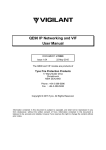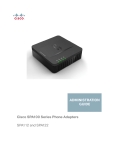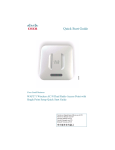Download Cisco SPA100 Series Phone Adapters Quick Start Guide
Transcript
Quick Start Guide Cisco SPA100 Series Analog Telephone Adapters SPA112 Two Port Phone Adapter SPA122 ATA with Router Package Contents • Analog Telephone Adapter • Ethernet Cable • Power Adapter • Quick Start Guide • Product CD-ROM Welcome Thank you for choosing a Cisco SPA100 Series Analog Telephone Adapter. This product family includes the following models: • SPA112 Two-Port Phone Adapter: 2 FXS ports and 1 10/100 WAN port. • SPA122 ATA with Router: 2 FXS ports, 1 10/100 WAN port, 1 10/100 LAN port, and built-in router. This guide describes how to physically install the equipment and how to get started with the configuration. 1 Before You Begin Before you begin the installation, make sure that you have the following equipment and services: • An active Internet account and Voice over IP account • Ethernet cable to connect to your broadband network device • Phone to connect to your SPA112/122 • Phone cable to connect your phone • Optional: Uninterruptible Power Supply (UPS) to provide backup power 2 Product Features Top Panel 2 Cisco SPA100 Series Analog Telephone Adapters Feature Phone 1 Phone 2 Internet System Description Steady green—On hook. Slow flashing green—Off hook. Off—Port not ready. Flashing green—Transmitting or receiving data through the WAN port. Off—No link. Steady green—System ready, IP address acquired. Slow flashing green—Acquiring IP address. (By default, uses DHCP.) Fast flashing green—Upgrading firmware. Off—No power or system can not boot up. Back Panel Feature Reset Description Using a paperclip or similar object, press this button briefly to restart the unit. Press and hold for 10 seconds to restore the factory default settings. Connect to an analog phone, using an RJ-11 phone cable. Phone 1, Phone 2 (Gray) Ethernet (Yellow) Can be used to connect to a device on your network, such as a computer, using an Ethernet cable. SPA122 Only Internet (Blue) Connect to a broadband network device (DSL or cable modem) or a network router, using an Ethernet cable. Power Connect to a power source, using the provided power adapter. Cisco SPA100 Series Analog Telephone Adapters 3 3 Connecting the Equipment NOTE For wall-mounting instructions, see Mounting the ATA, page 9. STEP 1 Connect one end of the provided Ethernet cable to the Internet (Blue) port. Connect the other end directly to your broadband network deviceConnect one end of a phone cable to the Phone 1 (Gray) port. Connect the other end to your analog phone or fax machine. STEP 2 Connect one end of another phone cable to another analog phone or fax machine. Connect the other end to the Phone 2 (Gray) port. STEP 3 SPA122 Only: Optionally, connect one end of an Ethernet network cable to the ETHERNET (Yellow) port of the ATA. Connect the other end to a device on your network, such as a computer. 239795 STEP 4 Connect the provided power adapter to the Power port. WAN 4 Cisco SPA100 Series Analog Telephone Adapters Configuration and Management of the ATA 4 You can use the web-based configuration utility to set up your ATA. You also can use the built-in Interactive Voice Response (IVR) system. Using the Web-Based Configuration Utility STEP 1 Connect your computer to the same subnet as the ATA. For example, if the ATA is connected to a LAN port on your router, also connect your computer to a LAN port on your router. Note: On SPA122, you can connect your computer to the ETHERNET (Yellow) port of the ATA. STEP 2 Power on your computer. NOTE: Make sure your computer’s Ethernet adapter is set to obtain an IP address automatically. For more information, refer to the Help for your operating system. STEP 3 Start a web browser on your computer. STEP 4 In the Address bar, enter the IP address of the ATA. • SPA112: Use the ATA’s IVR or your router’s configuration utility to find the dynamically assigned IP address of the ATA. For information about the IVR, see Using the IVR for Administration, page 6. • SPA122: In the Address bar, enter: 192.168.15.1 Note: 192.168.15.1 is the default local IP address of the ATA. STEP 5 To log in for the first time, enter the default username, admin, and the default password, admin. The password is case sensitive. STEP 6 Enter the Connection Type and settings required by your Internet Service Provider. Types include DHCP (the default option), Static IP, and PPPoE (required for most DSL service). After entering these settings, click Submit to establish your Internet connection. STEP 7 Use the menus to configure your settings, as needed. For more information, see the ATA Administration Guide. (Documentation links are provided in Where to Go From Here, page 11.) Cisco SPA100 Series Analog Telephone Adapters 5 Using the IVR for Administration An IVR system is available to help you to configure and manage your ATA. You can use the telephone keypad to select options and to make your entries. To access the IVR menu: STEP 1 Connect an analog phone to the Phone port of the ATA. STEP 2 Press the star key four times: **** STEP 3 After the greeting plays, press the keys on the phone keypad to select your options. STEP 4 Enter the code for the desired action. See the IVR Actions table for details. TIPS: • Enter the numbers slowly, listening for the audio confirmation before entering the next number. • After you select an option, press the # (pound) key. • To exit the menu, hang up the telephone or enter 3948# to exit. • After entering a value, such as an IP address, press the # (pound) key to indicate that you have finished your selection. To save the new setting, press 1. To review the new setting, press 2. To re-enter the new setting, press 3. To cancel your entry and return to the main menu, press * (star). • While entering a value, you can cancel the changes by pressing the * (star) key twice within half a second. Be sure to press the key quickly, or the * will be treated as a decimal point entry. • If the menu is inactive for more than one minute, the ATA times out. You will need to re-enter the menu by pressing the star key four times: ****. Your settings take effect after you hang up the telephone or exit the IVR. The ATA may reboot at this time. • To enter the decimal points in an IP address, press the * (star) key. For example, to enter the IP address 191.168.1.105, perform the following tasks: 6 – Press these keys: 191*168*1*105. – Press the # (pound) key to indicate that you have finished entering the IP address. – Press 1 to save the IP address or press the * (star) key to cancel your entry and return to the main menu. Cisco SPA100 Series Analog Telephone Adapters IVR Actions IVR Action Menu Option Enter IVR Menu **** Check Internet Connection 100 Type Set Internet Connection Type 101 Choices and Instructions DHCP: 0 Static IP: 1 PPPoE: Press 2 PPPoE, DHCP: Press 3 DHCP, PPPoE: Press 4 Check Internet IP Address (WAN port) Set Static IP Address (WAN) 110 111 Enter the IP address by using numbers on the telephone key pad. Use the * (star) key when entering a decimal point. Note: This option is available only after you choose Static IP as the Internet Connection Type, through option 101. Check Network Mask 120 Set Network Mask 121 To enter the value, press numbers on the telephone key pad. Press the * (star) key to enter a decimal point. Note: This option is available only after you choose Static IP as the Internet Connection Type, through option 101. Check Gateway IP Address 130 Cisco SPA100 Series Analog Telephone Adapters 7 IVR Action Set Gateway IP Address Menu Option 131 Choices and Instructions To enter the value, press numbers on the telephone key pad. Press the * (star) key to enter a decimal point. Note: This option is available only after you choose Static IP as the Internet Connection Type, through option 101. Check MAC Address 140 Check Firmware Version 150 Check Primary DNS Server Setting Set Primary DNS Server 160 161 To enter the value, press numbers on the telephone key pad. Press the * (star) key to enter a decimal point. Note: This option is available only after you choose Static IP as the Internet Connection Type, through option 101. Check Internet web server port SPA122 only: Check LAN IP address (Ethernet port) Announce Line 1 SIP Transport Set Line 1 SIP Transport 170 210 1910 1911 0: UDP 1: TCP 2: TLS Check Line 2 SIP Transport Set Line 2 SIP Transport 1920 1921 0: UDP 1: TCP 2: TLS Exit IVR 3948 Allow or prevent WAN access 7932 to the administration web server 8 1: Enable 0: Disable Cisco SPA100 Series Analog Telephone Adapters IVR Action Factory Reset of Unit Menu Option 73738 WARNING: All non-default RESET settings will be lost. This includes network and service provider data. Reboot of Voice System 732668 REBOOT User Factory Reset of Unit 877778 WARNING: All userchangeable non-default settings will be lost. This may include network and service provider data. 5 Choices and Instructions When prompted, press 1 to confirm, or press * (star) to cancel. After you hear “Option successful,” hang up the phone. The ATA reboots. After you hear “Option successful,” hang up the phone. The ATA reboots. When prompted, press 1 to confirm, or press * (star) to cancel. After you hear “Option successful,” hang up the phone. The ATA reboots. Mounting the ATA You can place the ATA on a desktop or mount it on a wall. CAUTION To prevent the ATA from overheating, do not operate it in an area that exceeds an ambient temperature of 104°F (40°C). Desktop Placement Place the ATA on a flat surface near an electrical outlet. WARNING Do not place anything on top of the ATA; excessive weight could damage it. Wall Mounting The ATA has two wall-mount slots on the bottom panel. To mount the ATA on a wall, you need mounting hardware (not included). Suggested hardware is illustrated (not true to scale). Cisco SPA100 Series Analog Telephone Adapters 9 Recommended hardware (not included): Two number-six pan-head tapping screws, 5/8-in. length, with anchors for sheet rock installation. 5/8 in. (15.8 mm) WARNING Insecure mounting might damage the ATA or cause injury. Cisco is not responsible for damages incurred by insecure wallmounting. To mount the unit to the wall: STEP 1 Determine where you want to mount the unit. Verify that the surface is smooth, flat, dry, and sturdy. STEP 2 Drill two pilot holes into the surface 58 mm apart (about 2.28 in.). STEP 3 Insert a screw into each hole, leaving a gap of 5 mm (0.1968 in.) between the underside of each screw head and the surface of the wall. STEP 4 Place the unit wall-mount slots over the screws and slide the unit down until the screws fit snugly into the wall-mount slots. 10 Cisco SPA100 Series Analog Telephone Adapters 6 Where to Go From Here Support Cisco Small Business Support Community www.cisco.com/go/smallbizsupport Cisco Small Business Support and Resources www.cisco.com/go/smallbizhelp Phone Support Contacts www.cisco.com/go/sbsc Cisco Small Business Firmware Downloads www.cisco.com/go/software Cisco Small Business Open Source Requests www.cisco.com/go/smallbiz_opensource_ request Product Documentation Cisco Small Business Analog Telephone Adapters www.cisco.com/go/smallbizvoicegateways Cisco Small Business Cisco Partner Central for Small Business (Partner Login Required) www.cisco.com/web/partners/sell/smb Cisco Small Business Home www.cisco.com/smb Cisco SPA100 Series Analog Telephone Adapters 11 Americas Headquarters Cisco Systems, Inc. 170 West Tasman Drive San Jose, CA 95134-1706 USA www.cisco.com Small Business Support, Global: www.cisco.com/go/sbsc 78-19933-01 Cisco and the Cisco Logo are trademarks of Cisco Systems, Inc. and/or its affiliates in the U.S. and other countries. A listing of Cisco's trademarks can be found at www.cisco.com/go/ trademarks. Third party trademarks mentioned are the property of their respective owners. The use of the word partner does not imply a partnership relationship between Cisco and any other company. (1005R) © 2011 Cisco Systems, Inc. All rights reserved.

























